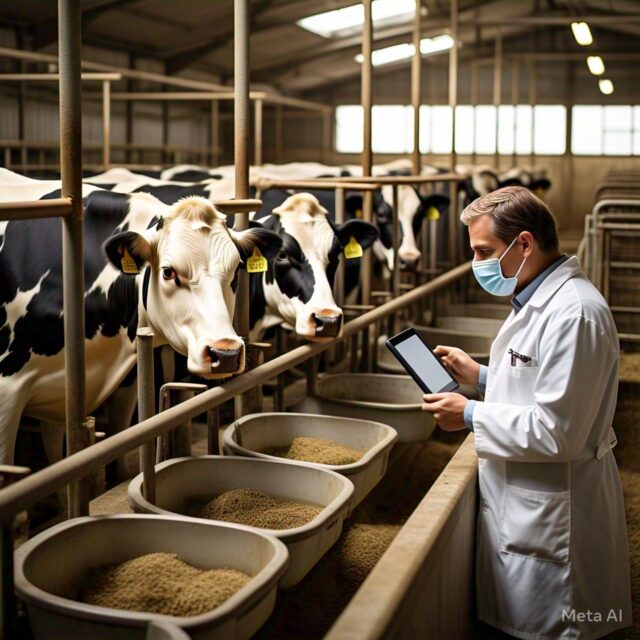
Animal Disease Prevention
Domesticated and wild animals, including livestock and wildlife, are vital to human society, contributing significantly to both economic and ecological systems. They provide essential resources such as food, fibre, and labour, and play a key role in maintaining biodiversity and ecosystem services. However, the health of these animal populations is constantly under threat from a variety of infectious and non-infectious diseases, which can lead to significant morbidity and mortality. These adverse effects not only impact the animals themselves but also have far reaching consequences for human communities, particularly in sectors such as agriculture and public health. A robust understanding of veterinary epidemiology and the application of biosecurity measures are essential for safeguarding animal populations and, by extension, human health.
Disease prevention forms the cornerstone of public health initiatives and is aimed at reducing the occurrence, transmission, and impact of diseases on populations. This is especially critical when considering the health of animals, particularly livestock, which are integral to human well-being. Livestock serve as a primary source of nutrition, economic security, and livelihoods for millions of people worldwide. Additionally, the health of animal populations is closely linked to the health of human populations, given the potential for zoonotic diseases those that can be transmitted between animals and humans to arise and spread.
Disease prevention in animals involves a multi-faceted approach, encompassing a broad understanding of the relationships between humans, animals, and the environment. Epidemiology, the study of the distribution and determinants of disease, plays a central role in understanding how diseases emerge, spread, and persist in animal populations. Effective prevention and control strategies must consider the various ecological, social, and economic factors that contribute to disease dynamics. These strategies are typically classified into four levels—primordial, primary, secondary, and tertiary prevention—with each targeting a specific stage in the disease process. Recently, a fifth level, quaternary prevention, has been added to address the prevention of over-medicalization. This structured approach to prevention not only ensures that diseases are tackled at multiple stages of their development but also provides a framework for developing comprehensive health policies for animals. Through the implementation of these preventive strategies, it is possible to maintain the health of animal populations, mitigate the economic losses caused by diseases, and protect human populations from zoonotic infections.
Classification of Prevention
- Primordial Prevention
Primordial prevention is concerned with addressing the underlying social, environmental, and economic factors that contribute to the emergence of diseases. At this level, the focus is on creating environments that reduce the likelihood of disease development by tackling the root causes. In human health, this may involve policies aimed at promoting healthy behaviors or improving living conditions. In the context of animal health, primordial prevention entails improving the overall conditions in which animals live to minimize their exposure to harmful factors.
For instance, ensuring that livestock have access to clean water, adequate shelter, and proper nutrition are fundamental steps in primordial prevention. Poor living conditions, such as overcrowding, unsanitary environments, and poor waste management, can create breeding grounds for infectious diseases. Addressing these environmental factors helps reduce the overall disease burden in animal populations, thereby decreasing the risk of disease transmission to humans.
- Primary Prevention
Primary prevention aims to stop diseases before they occur by reducing exposure to risk factors and enhancing the resistance of animals to infections. This level of prevention focuses on healthy individuals or populations and seeks to prevent the onset of diseases through various interventions. In veterinary medicine, primary prevention includes vaccination programs, health education, and management practices designed to limit animals’ exposure to infectious agents.
Vaccination is one of the most effective tools for preventing disease in livestock. For example, vaccines are commonly used to prevent diseases such as foot-and-mouth disease, rabies, and avian influenza, all of which can have devastating effects on animal populations and cause significant economic losses. In addition to vaccines, primary prevention may involve the implementation of biosecurity measures, such as quarantining new animals, disinfecting equipment and facilities, and controlling the movement of animals to prevent the introduction of diseases from external sources.
Nutrition also plays a critical role in primary prevention. Providing animals with a balanced diet rich in essential nutrients can help strengthen their immune systems, making them less susceptible to diseases. In addition to individual farm-level interventions, primary prevention efforts at the national level may involve the development of health policies that regulate animal movement, trade, and transportation to prevent the spread of infectious diseases across borders.
- Secondary Prevention
Secondary prevention focuses on the early detection and treatment of diseases to prevent their progression and limit their impact. This level of prevention is particularly important for detecting diseases in their early stages, often before animals exhibit clinical symptoms. Early diagnosis allows for timely intervention, which can reduce the severity of the disease and limit its spread within animal populations.Screening programs are a key component of secondary prevention. In livestock, this may involve routine testing for diseases such as tuberculosis, brucellosis, or parasitic infections. Diagnostic tools, such as serological tests, molecular diagnostics, and imaging techniques, are used to identify diseases at an early stage, enabling veterinarians to implement control measures quickly.
In addition to disease screening, secondary prevention includes the use of treatments to manage early-stage diseases. By providing appropriate medical care early on, secondary prevention aims to minimize disease transmission, prevent complications, and improve the overall health outcomes of affected animals. Veterinary professionals play a key role in monitoring animal health, conducting routine examinations, and advising farmers on the necessary steps to take when disease is detected.
- Tertiary Prevention
Tertiary prevention is concerned with managing diseases that have already progressed to an advanced stage, focusing on preventing complications, reducing morbidity, and improving the quality of life for affected animals. This level of prevention involves the treatment of established diseases and the implementation of measures to prevent further spread.
In the case of livestock, tertiary prevention may involve the treatment of diseases such as mastitis, pneumonia, or parasitic infections through the use of antibiotics, anti-parasitic agents, or supportive care. Rehabilitation programs are also part of tertiary prevention, ensuring that animals recover fully after treatment and reducing the likelihood of relapse.
In addition to individual animal care, tertiary prevention also includes efforts to contain disease outbreaks within animal populations. Culling infected animals, for example, is a common practice in livestock management to prevent the spread of highly contagious diseases. While this measure is often seen as a last resort, it can be necessary to prevent the widespread dissemination of infectious agents, especially in the case of zoonotic diseases that pose a risk to human health.
- Quaternary Prevention
Quaternary prevention is a more recent concept that focuses on protecting individuals from unnecessary or excessive medical interventions. In veterinary medicine, quaternary prevention aims to avoid over-treatment or the use of interventions that may cause harm or have little benefit. This is particularly relevant in the context of antimicrobial resistance, where the overuse of antibiotics in animal populations has contributed to the rise of drug-resistant pathogens.
By promoting responsible use of medications and emphasizing the importance of evidence-based veterinary practices, quaternary prevention seeks to minimize the risk of harm associated with over-medicalization. It encourages veterinarians to carefully weigh the risks and benefits of treatments and to consider non-invasive or preventive alternatives when appropriate.
The Role of Biosecurity in Disease Control
Biosecurity is an essential component of disease control in animal populations, particularly in livestock management. It refers to the set of practices and measures that are implemented to prevent the introduction and spread of infectious diseases. By maintaining high biosecurity standards, farms can reduce the risk of disease outbreaks, protect animal health, and safeguard public health by minimizing the potential for zoonotic transmission.
Key biosecurity measures include:
Access Control: Restricting access to animal facilities to prevent the introduction of pathogens. This may involve limiting access to essential personnel, using protective clothing, and disinfecting vehicles and equipment that enter the premises.
- Animal Movement Control: Managing the movement of animals to prevent the spread of disease. This includes isolating new animals before introducing them to the herd, monitoring the health status of animals being transported, and enforcing regulations for the safe transport of livestock.
- Hygiene Practices: Maintaining cleanliness in animal housing, feeding areas, and equipment to reduce the risk of contamination. Regular cleaning and disinfection, proper waste disposal, and the use of protective clothing are essential for minimizing the spread of disease.
- Health Monitoring: Conducting routine health checks and surveillance to detect early signs of disease. This allows for prompt intervention and helps prevent the spread of infectious agents within animal populations.
- Vaccination and Treatment: Ensuring that animals are regularly vaccinated and treated for common diseases to reduce the risk of outbreaks.
By implementing these measures, farms can maintain healthy animal populations and reduce the likelihood of disease transmission to humans. Biosecurity is not only important at the individual farm level but also at regional, national, and global levels. Governments and international organizations play a crucial role in enforcing biosecurity standards, monitoring animal health, and responding to disease outbreaks to protect both animal and human populations.
Conclusion
The prevention and control of diseases in animal populations are critical for ensuring the health and well-being of both animals and humans.
The interconnectedness of human and animal health underscores the importance of comprehensive disease prevention strategies. Globalization, increased trade, travel, and migration have contributed to the rapid spread of diseases across borders, while environmental changes such as climate change and urbanization have created new challenges for disease control. Additionally, the misuse of antibiotics has accelerated the development of antibiotic-resistant pathogens, posing a serious threat to both human and animal health.
To address these challenges, it is essential to adopt a multidisciplinary approach that combines veterinary epidemiology, biosecurity, and public health measures. Preventive strategies must be implemented at every level—primordial, primary, secondary, tertiary, and quaternary—to effectively manage and control the spread of diseases in animal populations. By fostering collaboration across sectors and ensuring that preventive measures are scientifically sound and appropriately applied, we can protect both animal and human health, promote sustainable agriculture, and safeguard global public health.
- References:–
- Anderson, T. J., & Rogers, P. D. (2021). Strategies for preventing zoonotic diseases in livestock populations. Journal of Veterinary Epidemiology, 36(2), 175-189.
- Brown, K. L., & Smith, R. A. (2020). Vaccination protocols for controlling infectious diseases in farm animals. Veterinary Clinics of North America: Food Animal Practice, 36(3), 427-443.
- Collins, D. F., & Thompson, E. J. (2019). The role of biosecurity measures in disease prevention on dairy farms. Preventive Veterinary Medicine, 167, 28-34.
- Martinez, M. A., & Garcia, F. L. (2018). Epidemiological approaches to control emerging animal diseases. One Health, 7, 100094.
- Olsen, B. R., & Nguyen, H. T. (2022). Mitigating viral outbreaks in poultry farms through improved sanitation practices. Poultry Science, 101(4), 2507-2515.
- Roberts, G. W., & Taylor, J. K. (2017). Integrating animal welfare and disease prevention: A case for holistic farm management. Animal Welfare Science, 26(1), 12-20.
Gurpreet Singh Preet1, Simran jeet Singh2, and Jagriti Upreti3
2PG Scholar, Department of Veterinary Medicine
1Assistant Professor, Department of Teaching Veterinary Clinical Complex
3BVSc & Ah Scholar
1Guru Angad Dev Veterinary and Animal Sciences University Ludhiana
2,3College of Veterinary and Animal Sciences, GB Pant University of Agriculture and Technology, Pantnagar, Udhamsingh Nagar, Uttarakhand- 263145

















